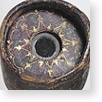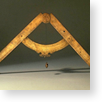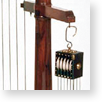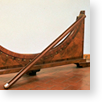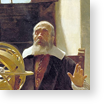The room dedicated to the great scientist is the heart of the Museo Galileo. Here are displayed the only two surviving telescopes, among the many built by Galileo; the objective lens of the telescope through which, in January 1610, he observed the satellites of Jupiter for the first time; the military and geometric compasses he developed during his years in Padua; other instruments of his invention and educational models illustrating the crucially important results attained by Galileo in his studies on mechanics. At the centre of the room is the marble bust commissioned of the sculptor Carlo Marcellini by Cosimo III de' Medici. Some relics of Galileo, the secular saint of science, are also exhibited here: his thumb, the index finger and middle finger from his right hand, and a tooth, removed from Galileo's corpse when it was translated to the monumental tomb in Santa Croce.
The Telescope: Observing and Measuring Astronomical Phenomena
Although the first "spyglasses" were fabricated in Holland in the early 17th century, Galileo alone immediately realized their great astronomical potential. ...
(8 objects)
Galileo’s Instruments
Galileo is justly famous for his revolutionary scientific theories, such as his concept of motion, a crucial element in confirming the Copernican structure ...
(8 objects)
Science of equilibrium
From his earliest writings, Galileo expressed unconditional admiration for Archimedes, whose works he saw as a model of scientific rigor. Galileo systematically ...
(6 objects)
Science of motion
Throughout his scientific career, Galileo conducted research into the nature and laws of motion. This quest culminated in the formulation of a totally ...
(5 objects)
Galilean iconography and relics
The relics exhibited at the Museo Galileo illustrate the celebration of Galileo as hero and martyr of science. On March 12, 1737, Galileo's remains were ...










